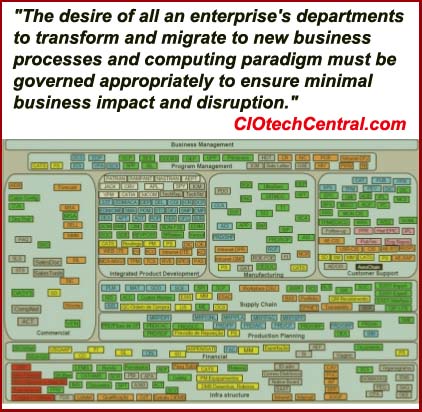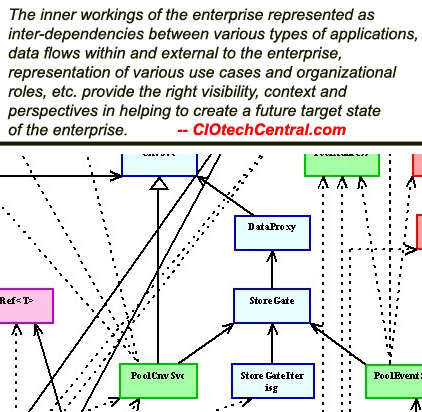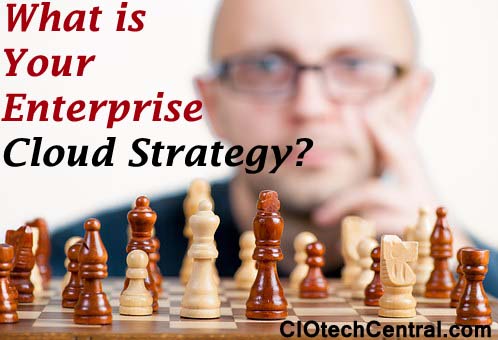If you are like most CIOs, your organization is probably already in the midst of a digital transformation where a number of your organization’s business functions are slowly becoming digitalized. From our experience with digital projects to date, we know now that as these technologies differ from their predecessors, an organization’s transformation to digital must be managed and governed methodically. A haphazard approach is not sustainable for the long term and can even backfire and lead to wasting your organization’s resources along with eroding your enterprise’s competitive positioning and advantage in the marketplace. On the other hand, a methodical approach such as the process of Enterprise Architecture (EA) can help an enterprise navigate through this change in a more controlled and effective fashion.
The necessity to manage and govern enterprise digital transformation
It’s no secret that digital transformation initiatives embarked upon by enterprises are impacting all facets of the enterprise. Even though digitalization sounds like that it’s ‘technology’ oriented, the fact is that everyone throughout the organization is involved. Various Lines of Businesses (LOBs) such as Product Development, Sales, HCM, Procurement, etc. are all vying to digitalize their business processes and to roll out new digital products and solutions to the marketplace including getting more functions and features for less by migrating to a cloud based platform, rolling our mobility based applications, etc. In fact, pressured by the competition, various LOBs of an enterprise seem to be more anxious than IT to roll out new solutions, thus in turn pressuring IT to become agile and responsive to LOB demands and requirements.
CIOs and other C-execs though have a responsibility to not let get this transformation out of control. Examples abound where initiatives such as Shadow IT, tactical cloud migrations, and ill conceived digital platforms are introducing more risk to the organization including exposing the enterprise to information security, regulatory, and privacy issues. These enterprise wide efforts of transformation therefore must be governed appropriately to ensure minimal business impact and disruption.

Here are some examples which demonstrate why injecting digital initiatives in the enterprise must be managed and governed carefully to prevent a negative impact on the continued business of the enterprise.
- Almost all LOBs are looking for ways to migrate to mobility based solutions to attain more flexibility and efficiency gains. An enterprise’s sales force, for example, may want to have access to all functions and features of a sales process through their mobile devices to help them become more effective. However, enabling all of an enterprise’s workforce to mobile based solutions can be a large enough change initiative that may overwhelm the backend systems, introduce security and privacy issues, require special design of the new user interface, etc. Furthermore, training of the workforce on the new mobile interface may require extensive training and longer transition times. This effort in larger enterprises can therefore be significant enough that may require a methodical transformation approach.
- Big data solutions are another example of opportunities offered by digital. Building of Big Data platforms requires enterprise wide involvement of LOBs and the IT department as they can help provide information on the data and information assets that are crucial to the enterprise and that can be used to feed the enterprise’s Big Data platform. This platform can then become the foundation for gleaning future insights. However, building such a platform that can provide cross LOB insights requires working with different segments of the enterprise and thus requires appropriate collaboration, communication and planning. Examples abound which show that Big Data solutions that were built but not aligned to business needs are not accepted by the business resulting in a loss of effort and resources.
- Enabling an enterprise’s business processes with social media access and technologies can lead to regulatory and privacy concerns that must be manage appropriately. For example, social media specific policies must be formulated and enforced to ensure that enabling of business functions and processes with social media features don’t result in unintended consequences that may hurt the organization’s brand.
- Migrating business functions and processes to new cloud based systems and platforms requires a strategic approach to ensure that an enterprise’s new cloud based computing platform is robust to handle all business requirements and is scalable for future requirements. This must be coordinated across the enterprise to ensure all LOB requirements are considered in the building of such a platform.
Enterprise Architecture’s role in Enterprise Transformation
Organizations have come to manage and govern transformations of all kinds in various ways. Enterprise Architecture (EA) is one such discipline that has been regarded as quite instrumental in spearheading business and related IT change and transformation initiatives. This is because an EA describes the enterprise in terms of its basic building blocks that includes business strategy, business processes, an organization’s business model to deliver value, enabling technologies and an organization’s products and services.
An EA, therefore, helps in establishing a common understanding of the enterprise that is essential before undertaking any major change or transformation initiatives. As an example, EA is regarded as a vital tool when enterprises go through mergers and acquisitions. One of the ways an EA can be helpful is that a detailed representation of the current state of the enterprise in terms of its constituent business processes and enabling systems and technologies brings into sharp focus the inner workings of the enterprise. These inner workings represented as inter-dependencies between various types of applications, data flows within and external to the enterprise, representation of various use cases and organizational roles, etc. provide the right visibility, context and perspectives in helping to create a future target state of the enterprise.

When represented at the right levels of detail, a documented EA blueprint provides a holistic view of the enterprise, its functions, enabling technologies and the underlying inter-dependencies. This helps all stakeholders to see and accordingly analyze the enterprise in a new light and context. High level executives, for example, may be able to see functional redundancies and opportunities for a better organizational alignment. LOB executives, on the other hand, who usually are focused primarily on running their own businesses can see strategic initiatives that may impact their organization along with ways in which they can better connect with other parts of the enterprise along with creating external partnerships. For example, based on the enterprise’s cloud strategic plans highlighted in the EA, the LOB executives related to sales, supply chain, or HR functions could foresee possibilities for their specific solutions.
Although, EA models, blueprints, inventory of applications and other technology and business artifacts, etc. are considered to hold real value in any transformation initiative, the real value lies in the process that is used to derive those artifacts. This is because such a process involves deep collaboration with various LOBs and other key stakeholders before a current and target architecture of the enterprise is realized and agreed upon. This collaborative process helps in not only aligning enterprise business processes with business strategy but also helps in bringing down the walls that exist between various LOBs.
EA also plays a critical role in the ongoing governance of IT. Once EA models are agreed upon between key stakeholders, the EA current and target blueprints serve as the baseline for an enterprise’s future decision making activities. For example, when considering the introduction of a major business system in the enterprise, the EA blueprints can help in assessing the impact of bringing in the new system into the folds of the enterprise.
Using Enterprise Architecture to Manage Digital Transformation
Based on EA’s earlier mentioned benefits, its role in an enterprise’s digital transformation becomes even more crucial. The growing complexity of the enterprises coupled with the fast pace of market driven change requires a methodical and a disciplined approach. Furthermore, the fact that the digital transformation initiatives are enterprise wide impacting the whole of the enterprise and its LOBs, along with an enterprise’s external stakeholders, makes EA’s role as central to the transformation effort. Also, the fact that many enterprises are currently building their digital foundations, it is incumbent to take a strategic rather than a tactical approach to prevent further muddying of the enterprise’s technology platform.
Digital transformation within the context of each enterprise is about the change that all enterprises are going through in response to the overall disruption caused by digital technologies (the so called ‘third platform’), which essentially constitute Social, Mobile, Analytics, and the Cloud. As these third platform technologies have resulted in a change of customer behaviors, their expectations, and the market changing to adapt to those behaviors and expectations, the enterprises have to transform to compete effectively to position themselves appropriately in the marketplace and the overall environment. For each enterprise, this means reassessing its products, services, and overall value proposition to ensure that it is aligned to its customers’ expectations and overall market demands.
Below are some examples in that show how EA can be instrumental in guiding and managing digital transformation initiatives within an enterprise.
- Enterprises are looking to migrate a number of their application workloads to the cloud, either by modernizing their legacy systems or through adoption of new SaaS solutions (e.g. Sales, Human Capital Management (HCM), Supply Chain Management, etc.) As an EA provides a holistic view of all the applications of the enterprise and their underlying platforms and inter-dependencies, the EA process can help in the development of a strategic migration plan from the current state to the target state rather than each department doing it on its own without taking into account the impact to other applications and systems.
- As digitalization of most business processes is necessitating building of a new cloud based backend that serves a number of LOBs, this must be coordinated with various LOBs and stakeholders. The current state blueprints provided by EA can help understand the broader scope of such a platform and help toward building a future state EA.
- Current trends clearly show that most enterprises are transitioning to hybrid cloud environments that are based on traditional on-premises infrastructure, private and public clouds, and other public digital platforms. Building this platform that will serve as the foundation for the whole enterprise again requires a strategic approach that takes into account appropriate details of the current environment, something that an EA process process can help in developing.
- Enterprises are enabling most of their applications and systems to work with mobile. This includes applications for external customer access as well as applications accessed by employees. This enablement requires unified standards in terms of the user interface design and other access requirements that in turn requires strategic planning. An EA also helps in adopting certain standards when injecting new technologies in the enterprise.
- Mobile devices have become the enablers of an online journey for customers, employees, external partners, as well as other stakeholders of the enterprise’s ecosystem. As EA provides a holistic view of all the business processes, users of those business processes along with the various use cases, it enables analysts and LOBs to see all the relevant business processes involved in specific customer journeys.
- The increasing reach of the applications and systems along with the need to understand customer and business partner behavior is necessitating intelligent business insights that are only possible through big data applications and analytics. Due to the high computing resources needed to run these applications, more enterprises are opting to run these in secure cloud environments where they have more flexibility and options related to costs and performance. Building of Big Data platforms requires enterprise wide involvement of LOBs and the IT department as they can help provide information on the data and information assets that are crucial to the enterprise and that can be used to feed the enterprise’s Big Data platform. This platform can then become the foundation for running future insights. The current state of the EA provides visibility of the various data stores in the enterprise along with the information feeds from other sources.
It’s quite obvious that injecting new digital solutions within the enterprise can disrupt the existing technology base of the enterprise. The discipline of EA, when instituted and used properly, can make the process much smoother and lead to predictable business outcomes.
— End




